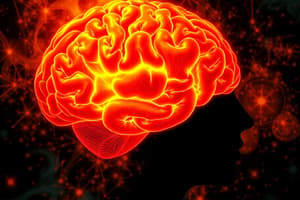Podcast
Questions and Answers
Which of the following is NOT considered a universal emotion, according to the text?
Which of the following is NOT considered a universal emotion, according to the text?
- Joy
- Loathing
- Surprise
- Anger (correct)
According to the provided text, what is the relationship between negative affect and workplace behavior?
According to the provided text, what is the relationship between negative affect and workplace behavior?
- Negative affect is unrelated to workplace behavior and performance.
- Negative affect leads to increased productivity and better collaboration in the workplace.
- Negative affect can contribute to more withdrawn behavior and less productive actions, such as theft and sabotage. (correct)
- Negative affect is directly linked to increased violence and aggression in the workplace.
The Yerkes-Dodson law describes the relationship between:
The Yerkes-Dodson law describes the relationship between:
- Cognitive ability and task complexity.
- Stress levels and job satisfaction.
- The Yerkes--Dodson law is an empirical relationship between pressure and performance, originally developed by psychologists Robert M.Yerkes and John Dillingham Dodson in 1908. The law dictates that performance increases with physiological or mental arousal, but only up to a point.
- Arousal level and performance. (correct)
- Emotional intelligence and leadership effectiveness.
Which of the following is NOT mentioned as a negative workplace behavior associated with negative affect?
Which of the following is NOT mentioned as a negative workplace behavior associated with negative affect?
What is the main idea of the Yerkes-Dodson law?
What is the main idea of the Yerkes-Dodson law?
Based on the text, what is the likely outcome of exceeding the optimal arousal level according to the Yerkes-Dodson law?
Based on the text, what is the likely outcome of exceeding the optimal arousal level according to the Yerkes-Dodson law?
What is a potential implication of the connection between negative affect and workplace behavior?
What is a potential implication of the connection between negative affect and workplace behavior?
In the article "What are emotions? And how can they be measured?", Scherer (2005) explores the multifaceted nature of emotions. Which of the following is NOT a key aspect of emotion that Scherer highlights in his research?
In the article "What are emotions? And how can they be measured?", Scherer (2005) explores the multifaceted nature of emotions. Which of the following is NOT a key aspect of emotion that Scherer highlights in his research?
Which of the following statements is TRUE about the Yerkes-Dodson law?
Which of the following statements is TRUE about the Yerkes-Dodson law?
The text suggests that a connection exists between negative affect and workplace safety. Which of the following is a plausible explanation for this?
The text suggests that a connection exists between negative affect and workplace safety. Which of the following is a plausible explanation for this?
What is the significance of the Yerkes-Dodson law in understanding workplace performance?
What is the significance of the Yerkes-Dodson law in understanding workplace performance?
The text suggests that negative affect can have a detrimental impact on workplace behavior. What is a potential strategy for mitigating this effect?
The text suggests that negative affect can have a detrimental impact on workplace behavior. What is a potential strategy for mitigating this effect?
Which of the following scenarios best captures the essence of a primary appraisal in the context of emotional situations?
Which of the following scenarios best captures the essence of a primary appraisal in the context of emotional situations?
Based on the provided text, what fundamental aspect underlies the differentiation of primary emotions like shame, guilt, and embarrassment?
Based on the provided text, what fundamental aspect underlies the differentiation of primary emotions like shame, guilt, and embarrassment?
What is the primary implication of the statement: "Internal self-attributions are the root cause of all self-conscious feelings"?
What is the primary implication of the statement: "Internal self-attributions are the root cause of all self-conscious feelings"?
A student is preparing for a presentation and feels a surge of nervousness. Based on the provided content, which type of appraisal process is MOST likely occurring?
A student is preparing for a presentation and feels a surge of nervousness. Based on the provided content, which type of appraisal process is MOST likely occurring?
Based on the text, what is the most likely consequence of an individual experiencing negative emotions like anger or humiliation at work?
Based on the text, what is the most likely consequence of an individual experiencing negative emotions like anger or humiliation at work?
The text emphasizes the link between emotional temperament and performance, stating that "People's emotional temperament has a direct impact on how well they perform in their professional and personal lives." Which of the following concepts BEST aligns with this emphasis?
The text emphasizes the link between emotional temperament and performance, stating that "People's emotional temperament has a direct impact on how well they perform in their professional and personal lives." Which of the following concepts BEST aligns with this emphasis?
Which of the following scenarios BEST demonstrates an individual attributing external blame for their actions, as described in the text?
Which of the following scenarios BEST demonstrates an individual attributing external blame for their actions, as described in the text?
Which of the following statements about the relationship between emotions and job performance is TRUE?
Which of the following statements about the relationship between emotions and job performance is TRUE?
Which statement BEST reflects the core argument regarding the role of cognitive appraisal in understanding emotions?
Which statement BEST reflects the core argument regarding the role of cognitive appraisal in understanding emotions?
Flashcards
Emotions
Emotions
Reactions to events or cognitive feelings experienced by individuals.
Types of Universal Emotions
Types of Universal Emotions
Six primary emotions recognized universally: joy, sorrow, despair, loathing, frustration, surprise.
Subjective Experience
Subjective Experience
The personal feeling aspect of emotions that includes universal types.
Physiological Response
Physiological Response
Signup and view all the flashcards
Behavioral Response
Behavioral Response
Signup and view all the flashcards
James-Lange Theory
James-Lange Theory
Signup and view all the flashcards
Cannon-Bard Theory
Cannon-Bard Theory
Signup and view all the flashcards
Joy
Joy
Signup and view all the flashcards
Sorrow
Sorrow
Signup and view all the flashcards
Surprise
Surprise
Signup and view all the flashcards
Cognitive Appraisal
Cognitive Appraisal
Signup and view all the flashcards
Primary Appraisal
Primary Appraisal
Signup and view all the flashcards
Secondary Appraisal
Secondary Appraisal
Signup and view all the flashcards
Attribution
Attribution
Signup and view all the flashcards
Internal Attribution
Internal Attribution
Signup and view all the flashcards
External Attribution
External Attribution
Signup and view all the flashcards
Self-Conscious Emotions
Self-Conscious Emotions
Signup and view all the flashcards
Emotional Temperament
Emotional Temperament
Signup and view all the flashcards
Positive Affect
Positive Affect
Signup and view all the flashcards
Negative Emotions and Performance
Negative Emotions and Performance
Signup and view all the flashcards
Emotional Expressions
Emotional Expressions
Signup and view all the flashcards
Physiological Arousal
Physiological Arousal
Signup and view all the flashcards
Threat Appraisal
Threat Appraisal
Signup and view all the flashcards
Challenge Appraisal
Challenge Appraisal
Signup and view all the flashcards
Crisis Communication
Crisis Communication
Signup and view all the flashcards
Emotions in Crises
Emotions in Crises
Signup and view all the flashcards
Deep Physiological Detection
Deep Physiological Detection
Signup and view all the flashcards
Performance at Work
Performance at Work
Signup and view all the flashcards
Diary Study
Diary Study
Signup and view all the flashcards
Negative Affect
Negative Affect
Signup and view all the flashcards
Withdrawal Behavior
Withdrawal Behavior
Signup and view all the flashcards
Yerkes-Dodson Law
Yerkes-Dodson Law
Signup and view all the flashcards
Mental Arousal
Mental Arousal
Signup and view all the flashcards
Performance Drop
Performance Drop
Signup and view all the flashcards
Accidents at Work
Accidents at Work
Signup and view all the flashcards
Counterproductive Work Behavior
Counterproductive Work Behavior
Signup and view all the flashcards
Effects of Negative Emotions
Effects of Negative Emotions
Signup and view all the flashcards
Optimal Arousal Level
Optimal Arousal Level
Signup and view all the flashcards
Study Notes
Emotions and Emotional Responses
- Emotions are people's reactions to events or circumstances, including their feelings.
- The type of emotion depends on the situation. For example, hearing good news causes happiness, and danger causes fear.
- Six universal emotions include joy, sorrow, despair, loathing, frustration, and surprise.
- Emotions have three components:
- Subjective experience: the six universal emotions one is feeling
- Physiological response: physical reactions to emotions (e.g., increased heart rate with anxiety)
- Behavioral/expressive response: interpreting emotions through body language and facial expressions.
Critical Appraisal of James-Lang and Cannon-Bard Theories
- James-Lange theory suggests emotions follow physical reactions.
- Cannon-Bard theory suggests emotions and physical reactions occur simultaneously.
- The theories differ concerning the timing of emotional and physical responses.
Cognitive Appraisal of Primary Emotions
-
Primary emotions are assessed cognitively when a person considers how an event will affect them.
-
Two steps are involved:
- Primary appraisal: evaluating how a situation affects people
- Secondary appraisal: determining appropriate responses based on the situation.
- Often happens in situations with no obvious physical cues.
-
Differentiation of emotions such as shame, guilt and embarrassment stem from cognitive appraisals.
-
Attribution is the process of explaining the reasons behind a behavior or event. -Internal attribution (self blame) leads to self-conscious emotions.
- External attribution (blaming external factors) avoids self-blame.
Emotions and Performance
- Emotions significantly impact job performance.
- Positive emotions (e.g., rewards, support) enhance task performance.
- Negative emotions (e.g., anger, humiliation) can negatively affect work quality.
- Positive emotions enhance organizational citizenship behavior (e.g., helping coworkers).
- Negative emotions can increase negative work behaviors like sabotage or absenteeism.
Yerkes-Dodson Law
- The Yerkes-Dodson law states that performance increases with arousal up to a point.
- Very low and very high arousal levels both lead to poor performance. An optimal level exists for each person.
Studying That Suits You
Use AI to generate personalized quizzes and flashcards to suit your learning preferences.




